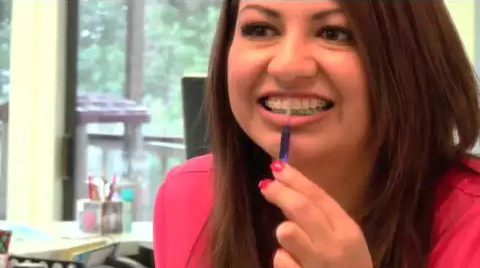Traditional Braces
Traditional metal braces are the most common of the different types of braces. They work by wearing metal brackets and an orthodontic wire that is held in place by rubber bands or ligatures, slowly moving your teeth into place. Metal braces provide you with the option for adding colored elastics for a unique, colorful smile. The colored bands are changed periodically throughout the course of treatment. Clear elastics may be used instead of colored bands and are slightly more conservative in appearance, but the orthodontic wire and brackets are still very visible. The orthodontic wire helps to shape the position of the teeth by creating tension between the brackets. Different sized wires aid in the movement of the teeth depending on the phase of treatment.
Ceramic Braces
Made of clear materials, ceramic braces are less visible than traditional braces. Older teenagers and adult patients with cosmetic concerns are the most frequent users of ceramic braces. Though ceramic braces are visually less prominent, they are also larger than traditional braces. Ceramic braces tend to be used on upper front teeth rather than on lower teeth.

Getting Used to Wearing Braces
- To minimize soreness take Tylenol or Advil.
- Brackets may cause some irritation. If this occurs:
- Use wax to stop the irritation
- Use a warm salt water rinse to heal the irritation
- Some over-the-counter products such as Zilactin-B may help as well
How to keep your Teeth Clean
Tooth Brushing
When: Brush after every meal and rinse after snacks.With: A soft-bristle toothbrush and fluoride toothpaste.
How: Use a dry brush with a small amount of toothpaste. Use circular motions around the gum lines and the surfaces of your teeth, 10 Seconds on each tooth. At an angle, work bristles of brush over, under and past the wire that runs From one tooth to another. Then brush the chewing surfaces of your teeth and brush your tongue and the roof of your mouth as well. Rinse thoroughly.
Dental Floss
When: At least 3 times a week.With: Dental floss and floss threader.
How: Insert floss into threader. Place threader between gums or under the wire. Floss using an up and down motion along the teeth. When you are finished look in the mirror to be sure your teeth and braces are shiny and your gums are firm. If your gums are sore and/or bleeding, rinse them with salt water. These problems will quickly disappear with proper oral hygiene.
Quick Fixes
With new braces, irritation can occur. This can be alleviated by:
- Rolling a small piece of orthodontic wax into a pea size ball, place it over the area of the braces, which are causing irritation.
- Try tucking it in with the end of an eraser or a spoon. If that does not work, dry it with a tissue, then place wax over the wire to prevent further sticking.
Foods To Avoid

- Ice
- Popcorn
- Hard candy
- Nuts
- Granola bars
- Pretzels
- Caramels
- Dried fruit
- Do not suck on lemons, limes
- Raw vegetables & apples should be steamed or cut
- Pizza crust & hard breads (i.e., french bread and bagels should be broken & eaten in small pieces)
- Corn (should be cut off the cob)



 (830) 896-5400
(830) 896-5400


